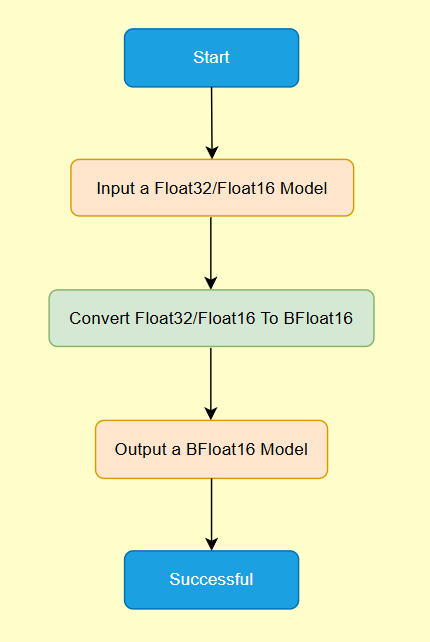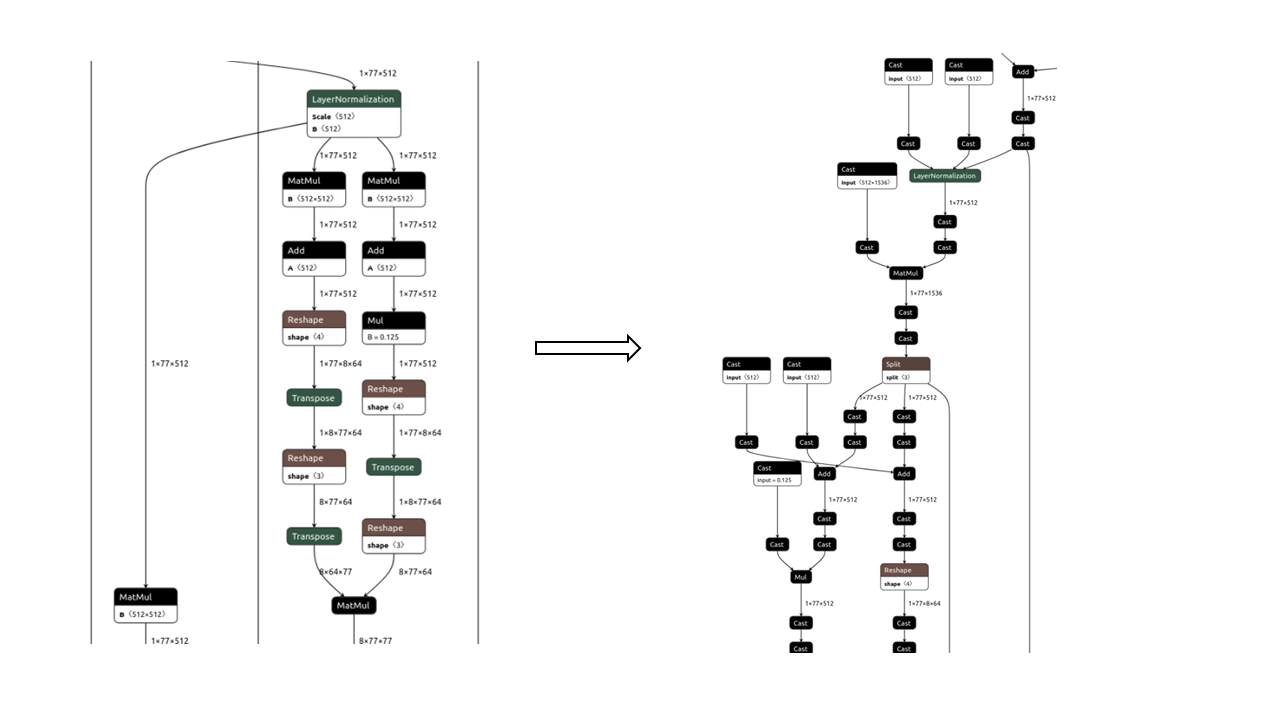FP32/FP16 to BF16 Model Conversion#
Note
In this documentation, AMD Quark is sometimes referred to simply as “Quark” for ease of reference. When you encounter the term “Quark” without the “AMD” prefix, it specifically refers to the AMD Quark quantizer unless otherwise stated. Please do not confuse it with other products or technologies that share the name “Quark”.
Introduction#
BFloat16 (Brain Floating Point 16) is a floating-point format designed for deep learning, offering reduced memory usage and faster computation while maintaining sufficient numerical precision.
AMD’s latest NPU and GPU devices natively support BF16, enabling more efficient matrix operations and lower latency. This guide explains how to convert an FP32/FP16 model to BF16 using Quark.

Figure 1. How to Convert FP32/FP16 to BF16#
How to Convert FP32 to BF16#
As the Figure 1 shows, you can use this command to convert a float32 model to bfloat16:
python -m quark.onnx.tools.convert_fp32_to_bf16 --input $FLOAT32_ONNX_MODEL_PATH --output $BFLOAT16_ONNX_MODEL_PATH --format with_cast
How to Convert FP16 to BF16#
As the Figure 1 shows, you can use this command to convert a float16 model to bfloat16:
python -m quark.onnx.tools.convert_fp16_to_bf16 --input $FLOAT16_ONNX_MODEL_PATH --output $BFLOAT16_ONNX_MODEL_PATH --format with_cast
Note
In the conversion, graph optimization and saturation (overflow protection) will be automatically performed, and the ONNX converted from float32/float16 to bfloat16 looks like Figure 2. As you can see, compared to the float32/float16 model on the left, the bfloat16 model on the right includes additional pairs of Cast operations and some graph optimizations, for example merging three MatMul operations into one.

Figure 2. Convert FP32/FP16 Models to BF16#
How to Measure Accuracy (Compare Differences between FP32/FP16 and BF16)#
infer float/float16 and bfloat16 models and save results
You can refer to the following code to infer the float32/float16 and bfloat16 models and save the results.
import numpy as np
import os
import onnxruntime as ort
def infer_model_and_save_output(onnx_model_path, input_data_loader, output_dir):
ort_session = ort.InferenceSession(onnx_model_path)
# Assume the model has only one input.
input_name = ort_session.get_inputs()[0].name
for index, input_data in enumerate(input_data_loader):
ort_inputs = {input_name: input_data}
ort_outs = ort_session.run(None, ort_inputs)
output_numpy = ort_outs[0]
os.makedirs(output_dir, exist_ok=True)
output_file = os.path.join(output_dir, str(index) + ".npy")
np.save(output_file, output_numpy)
print(f"Results saved to {output_dir}.")
onnx_model_path = "float32_model.onnx" # Replace with "float16_model.onnx" or "bfloat16_model.onnx"
# input_data_loader is an iterable object that returns a numpy tensor each time. It is user-defined.
output_dir = "baseline_results" # Replace with "quantized_results"
infer_model_and_save_output(onnx_model_path, input_data_loader, output_dir)
calculate differences
If you need to compare the differences between float32/float16 and bfloat16 models after conversion. We support some metrics (cosine similarity, L2 loss, PSNR) for comparing differences between float32/float16 and bfloat16 inference results. The formats (JPG, PNG and NPY) of inference result in folders are supported. you can use this command to compare:
python -m quark.onnx.tools.evaluate --baseline_results_folder $BASELINE_RESULTS_FOLDER_PATH --quantized_results_folder $QUANTIZED_RESULTS_FOLDER_PATH
How to Improve BF16 Accuracy#
If the accuracy of bfloat16 model can not meet your target, you can improve bfloat16 accuracy with adaquant finetuning. Here is a simple example of how to improve BF16 accuracy. NumIterations and LearningRate are two important parameters for improving accuracy during the finetuning process. Their explanations are as follows. For more detailed information, see BF16 Quantization.
NumIterations: (Int) The number of iterations for finetuning. More iterations can lead to better accuracy but also longer training time. The default value is 1000.
LearningRate: (Float) Learning rate for finetuning. It significantly impacts the improvement of fast finetune, and experimenting with different learning rates might yield better results for your model. The default value is 1e-6.
from quark.onnx import ModelQuantizer, ExtendedQuantType, ExtendedQuantFormat
from quark.onnx.quantization.config.spec import QLayerConfig, BFloat16Spec, CalibMethod
from quark.onnx.quantization.config.algorithm import CLEConfig, AdaQuantConfig
activation_spec = BFloat16Spec(calibration_method=CalibMethod.MinMax)
weight_spec = BFloat16Spec(calibration_method=CalibMethod.MinMax)
algo_conf = [CLEConfig(), AdaQuantConfig(num_iterations=1000, learning_rate=1e-6)]
extra_info = {
'BF16QDQToCast': True,
'QuantizeAllOpTypes': True,
'ForceQuantizeNoInputCheck': True,
}
config = QConfig(QLayerConfig(activation=activation_spec, weight=weight_spec), algo_config=algo_conf, **extra_info)
quantizer = ModelQuantizer(config)
quantizer.quantize_model(input_model_path, output_model_path, data_reader)